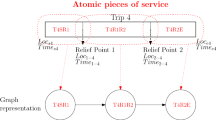Abstract
Empty-vehicle travel time plays an important role in the design and control of automated guided vehicle systems (AGVSs). However, many analytical models of these systems assume the amount of empty-vehicle travel time is the same as the loaded-vehicle travel time. This paper examines empty-vehicle travel time in AGVSs with low traffic intensity. The model uses a discrete-time Markov chain based on vehicle location and represents dispatching rules in the one-step transition matrix. The model can be used to compute moments and cumulative probabilities for the empty-vehicle travel time. Coupled with the loaded-vehicle travel time and the loading/unloading time, similar results can be obtained for the time to service a load request.
Similar content being viewed by others
References
Hodgson, T., King, R. and Monteith, S. (1987) Develo** con-trol rules for an AGVS using Markov decision processes. Material Flow, 4(1), 85–96.
Schwind, G. (1990) AGVS: latest developments in guidance sys-tems. Material Handling Engineering, November: 53-60 (1990).
Egbelu, P. and Tanchoco, J. (1984) Characterization of automatic guided vehicle dispatching rules, International Journal of Produc-tion Research, 22(3), 359–374.
Malmborg, C. (1990) A model for the design of zone control automated guided vehicle systems. International Journal of Pro-duction Research, 28(10), 1741–1758.
Egbelu, P. (1987) The use of non-simulation approaches to esti-mating vehicle requirements in an automated guided vehicle based transport system. Material Flow. 4(1-2), 33–51.
Kaspi, M. and Tanchoco, J. (1990) Optimal flow path design of uni-directional AGV Systems. International Journal of Production Research, 28(6), 1023–1030.
Malmborg, C. and Shen, Y.-C. (1994) Heuristic dispatching models for multi-vehicle materials handling systems. Applied Mathematical Modelling, 18, 124–133.
Shen, Y.-C. (1995) The impact of vehicle dispatching on the design of multiple-transporters material handling systems. Ph.D. dissertation, Virginia Polytechnic Institute and State University, Blacksburg, VA.
Shen, Y.-C. and Kobza, J.E. (1997) A dispatching-rule based al-gorithm for automated guided vehicle systems design. Production Planning and Control, (to appear).
Srinivasan, M., Bozer, Y. and Cho, M. (1994) Trip-based material handling systems: throughput capacity analysis. IIE Transactions, 26(1), 70–89.
Ross, S. (1993) Introduction to Probability Models, Academic Press, Inc, San Diego, CA.
Author information
Authors and Affiliations
Rights and permissions
About this article
Cite this article
Kobza, J.E., Shen, YC. & Reasor, R.J. A stochastic model of empty-vehicle travel time and load request service time in light-traffic material handling systems. IIE Transactions 30, 133–142 (1998). https://doi.org/10.1023/A:1007410016136
Issue Date:
DOI: https://doi.org/10.1023/A:1007410016136




